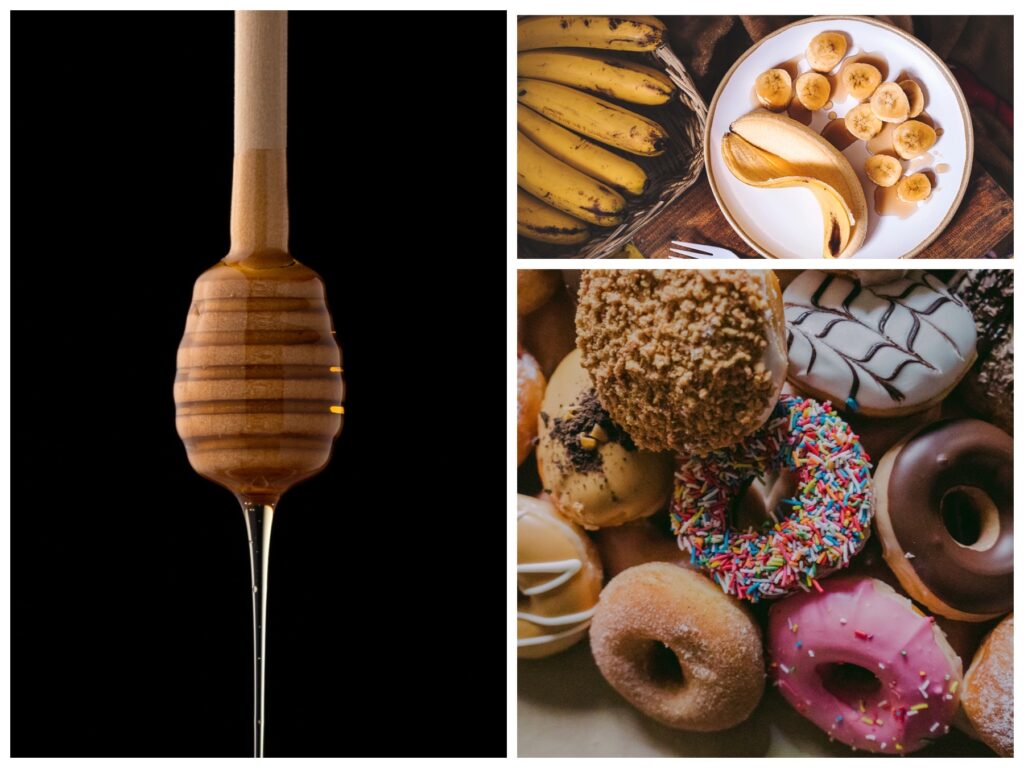Sugar: Which Type is Best?

We’ve all been there: it’s a Saturday night and you finally get a chance to sit on the couch after your longest day of training, cheering your kids at soccer games, and a few hours of yard work. You are hungry, tired, and dreaming of finishing the night off with something sweet.
You want something that will satisfy this craving, but also want a treat that won’t derail the progress you’ve been making in your training.
Your recipe search on Google may look something like “healthy desserts” or “healthy sugar substitutes for brownies”. Thousands of results pop up, but all with varying options of what a “healthy” dessert or sugar substitute should be.
Sugar: Which Type Is Best?
Digesting Sugar
Have you ever thought about sugar and which type is best for you? Before we dive into the differences & considerations between different types of sugar, it’s important to understand how the body processes sugars in the body. When any carbohydrate-rich food is chewed & digested, that food will eventually be broken down into one or more kinds of simple sugars: glucose, fructose, or galactose. Once broken down into their simplest form, those simple sugars are used by the body for energy.
Ultimately, this pattern remains constant whether you are eating carbohydrates from a carrot or a brownie. The main differences lie in how long it takes for a particular food to be broken down, what other nutrients are also absorbed along with the food, and how the food feels in your body specifically.
Different Kinds of Sugar
There are many different kinds of sugar for us to choose from. Some of the most common sweeteners used include maple syrup, honey, monk fruit, dates, and cane sugar. In this table, you can see the differences and similarities between these kinds of sweeteners.

When it comes down to it, the chemical composition of different sugars and their effect on our bodies are too similar to make a general statement regarding which one is “best.” Most sweeteners available come from purely natural sources at one point. All are processed to some extent to make them available for use.
With the exception of non-nutritive sweeteners (like monk fruit), all sweeteners increase blood sugar and should be paired with protein, fat, and fiber in order to keep blood sugar levels more stable on a regular basis. Unless you are drinking copious amounts of maple syrup or honey on a regular basis, the amount of beneficial compounds found in the portion of sweetener consumed will not have a significant impact on your overall nutrition status. Benefits of increased vitamin, mineral, and other phytochemical properties found in maple syrup, honey, and dates can also be found in other foods that should be included in greater amounts in a balanced and healthy diet.
Long-term benefits of using non-nutritive sweeteners may or may not be present. While the initial blood glucose spike after 1 hour of consuming a sweetener like monk fruit compared to regular cane sugar may be lower, blood glucose levels after 3 hours are the same. Many feel that the lack of calories in a non-nutritive sweetener is a benefit, but research shows that when eating intuitively, most people will make up for those calories elsewhere in their diet later on in the day.
So What Really Matters?
Rather than focusing on which sugar is the “healthiest,” I would encourage you to consider the portion, timing, and satisfaction factor when choosing which sugar to use.
Choose portions that feel good in your body! Often people find themselves justifying an over-consumption of certain sweets when using sweeteners believed to be superior or “healthy.” In reality, any kind of sweetener used should be consumed in moderate amounts and timed appropriately with your body’s immediate needs.
Aim to eat simpler carbohydrates surrounding your workout and more complex carbohydrates at other times of the day. Simple carbohydrates (like the kinds of sweeteners we have been discussing) are ideal sources of energy for athletes before, during, and immediately after a workout. They are our body’s quickest form of energy. More complex carbohydrates (think fruits, vegetables & whole grains) take longer to digest and provide more subtle & sustained energy when we are not actively moving our bodies. In reality, we need all kinds of carbohydrates in our diets, especially as athletes.
When considering the type of sugar to use, it’s perfectly ok to consider factors beyond nutrition. Which sweetener will fit your taste, texture, and appearance preferences? Choose to use a sweetener that will make your food look and taste the way you want it to. People generally eat less food overall and have higher satisfaction levels when they eat foods they sincerely like & enjoy.
Wrapping It Up
As an athlete striving to do everything you can to perform at your very best, know that you can choose any variety of sweetener to use when making a sweet treat. Each has their pros and cons, and most are quite identical in regards to their effect on the body. When the question of sugar and which type is best comes up. Instead of focusing on the specific kind of sugar you are using, focus instead on the portion, timing, and satisfaction factor when making your decision.
References
- Difference between monosaccharide, disaccharide, and polysaccharide. A Level Biology. https://alevelbiology.co.uk/notes/monosaccharide-disaccharide-polysaccharide/. Accessed May 10, 2023.
- Saraiva A, Carrascosa C, Ramos F, Raheem D, Lopes M, Raposo A. Maple Syrup: Chemical Analysis and Nutritional Profile, Health Impacts, Safety and Quality Control, and Food Industry Applications. Int J Environ Res Public Health. 2022 Oct 21;19(20):13684. doi: 10.3390/ijerph192013684. PMID: 36294262; PMCID: PMC9603788.
- Samarghandian S, Farkhondeh T, Samini F. Honey and Health: A Review of Recent Clinical Research. Pharmacognosy Res. 2017 Apr-Jun;9(2):121-127. doi: 10.4103/0974-8490.204647. PMID: 28539734; PMCID: PMC5424551.
- White JS. Straight talk about high-fructose corn syrup: what it is and what it ain’t. Am J Clin Nutr. 2008 Dec;88(6):1716S-1721S. Doi: 10.3945/ajcn.2008.25825B. PMID: 19064536.
- Shivani, Thakur BK, Mallikarjun CP, Mahajan M, Kapoor P, Malhotra J, Dhiman R, Kumar D, Pal PK, Kumar S. Introduction, adaptation and characterization of monk fruit (Siraitia grosvenorii): a non-caloric new natural sweetener. Sci Rep. 2021 Mar 18;11(1):6205. doi: 10.1038/s41598-021-85689-2. PMID: 33737610; PMCID: PMC7973523.
- Siddeeg A, Zeng XA, Ammar AF, Han Z. Sugar profile, volatile compounds, composition and antioxidant activity of Sukkari date palm fruit. J Food Sci Technol. 2019 Feb;56(2):754-762. doi: 10.1007/s13197-018-3534-y. Epub 2018 Dec 10. PMID: 30906033; PMCID: PMC6400747.
- Tribole, Evelyn. (2012). Tribole, E. and E. Resch. 2012. Intuitive Eating, 3rd edition. St. Martin’s Press, NY:NY..
Advertisement

Jackie Hendrickson RD, MPH is a registered dietitian with a Masters Degree in public health nutrition from Utah State University. Jackie is the owner of Enduura Nutrition and loves coaching her athletes to their athletic potential through sustainable training & nutrition principles. She is an avid road & trail marathoner with a background in collegiate track, cross country, and competitive swimming. Jackie and her husband, Adam, were teammates in college and continue to pursue their running goals together. They live in beautiful Ogden, Utah with their 2 year old son, Lincoln.









